If you are using Chrome, click the red hand button at the top right of the screen:

Then select: Don't run on pages on this site
If you do it correctly, the red hand will turn to green and you will no longer see this message.
This article appeared in the Lincoln Daily News on November 13, 1914.
To those living in Silesia, Moravia, and along the southern frontier of Hungary the word "vampire" has a terrible significance, says the New York Times. For centuries pas the inhabitants of these countries have believed implicitly in such terrible beings, and assert that their belief is founded upon only too real evidence. Travelers who scoff at these assertions have more than once had cause to change their minds owing to some tearful experience of their own. For the benefit of the reader we shall describe, first of all, just what a vampire is, according to those who are most familiar with this terrible being and his ways.
Certain persons who have died, it is said, have the power of leaving their graves, in sense form, and returning to suck the blood of living persons, and in this manner they are enabled to maintain themselves in a state, if not of life, certainly very different from death. Fastening upon their victim, they suck out the life blood through two small needle-like holes which they make in the victim's neck. They sit upon the chest lie an incubus during sleep. Preferably they attack young persons who are full-blooded and have an abundance of vitality.
Occasionally these persons wake during the process, and frightful have been some of the battles that are said to have taken place between mortal and and vampire. Sometimes one and sometimes the other would be victor. Most commonly, however, the person so attacked would not wake, and then he or she would rise in the morning pale, weak, emaciated and exhausted, for no apparent reason. This went on, as a rule, until that person died, when another would be attacked in like manner. This would continue until the vampire would be finally caught, exhumed, his head cut off, his heart cut out or impaled, when, with a fearful shriek, he would finally "give up the ghost." When the body of the vampire was impaled fresh blood would gush out. The body would be so full of blood, on occasion, that it would scarcely hold it all, and it would be found exuding from the ears, eyes and even skin! Any person bitten by a vampire would become one himself when his turn came to die. Such is the fearsome belief still held by many of the inhabitants of the Transylvania mountains and in the countries mentioned. The following cases are typical of many that might be given.
"Mr Tulip was an extraordinary strong well-built and healthy man, but at the beginning of December last he suddenly began to fail in health. The doctors could not locate his disease, and he grew rapidly thinner and weaker, complaining of nothing but extreme lassitude and feeling like a person who was daily bled. Finally, on December 20 last, all Vienna was surprised to hear that Mr Tulip dies. Post-mortem examinations showed all the organs in a perfectly normal condition, and the doctors found nothing better to register than marasmus (emaciation) as the cause of this extraordinary event. Strange to say, during the last days of his disease when his mind became flighty, he often imagined that a stranger was troubling him, and the description he gave of that personage fitted a certain Mr. Helleborus, with whom he had quarreled some time before.
"During Mr. Tulip's illness news come from Meran that Mr Helleborus, who had been very ill was rapidly gaining in health and strength and recovering from his illness in a most remarkable manner, yet immediately after the death of Mr. Tulip Mr Helleborus failed and died."
Another case is the following:
"A miller at D--- had a healthy servant boy, who soon after entering his service began to fail. He had a ravenous appetite, but nevertheless grew daily more feeble and emaciated. Being interrogated, he at last confessed that a thing he could not see, but which he could plainly fee, came to him every night and settled upon his stomatch, drawing all the life out of him, so that he became paralyzed for the time being and could neither move nor cry out. Thereupon the miller agreed to share the bed with the boy, and proposed to him that he should give him a certain sign when the vampire arrived. This was done and when the sign was given the miller grasped an invisible but very tangible substance that rested upon the boy's stomach and, though it struggled to escape, he held it firmly and threw it into the fire. After that the boy recovered, and there was an end of those visits.
Cases such as these might be multiplied indefinitely. What is one to think of such happenings? Like all beliefs of the kind, we must assume that there is some residium of truth amid the error and superstition. It cannot all be imagination. But if there is any truth in these stories, how much, and what is it?
About 200 years ago a learned priest, by name Augustine Calmet, published a work in two volumes, in which he critically examined a number of these stories of vampires. After narrating a number of them he goes on to say: "I lay down at first this principle -- that it may be that these are corpses which, although interred some days, shed fluid blood through the pores of their bodies." Although this is hardly the case, under certain peculiar conditions something akin to it may take place and thus give rise to the stories where fresh blood is found in the corpse.
As to the death of some of the persons who were attacked by vampires, Calmet says, "I add, moreover, that it is very easy for certain people to fancy themselves sucked by vampires, and that the fear caused by that fancy should make a revolution in their frame sufficiently violent to deprive them of life."
Had he lived in these days he would have put such cases down to the "influence of suggestion."
There are cases on record where the beard, hair, nails, etc. are found to have grown after death, and this was thought to be a sign of vampirism. But to this Calmet says:
"Experience teaches us that there are certain kinds of earth which reserve dead bodies perfectly fresh. ...As to the growth of the nails, the hair and the beard, it is often perceived in corpses. While there yet remains a good deal of moisture in the body, it is not surprising that sometimes we see some augmentation in those parts which do not demand a vital spirit.
As to the cry uttered by the vampires when the stake is driven through the heart, nothing is more natural; the air is there confined, and thus expelled by violence necessarily produces that noice in passing through the throat."
While much of Mr. Calmet's physiology is a little shaky, still he has grasped the main truth of the question. He saw that natural physical causes operating in the body produced, on occassion, those odd changes and influences which were thought to be proff of vampirism.
Yet the difficult problem still remains. How does the body get out of its grave to come and haunt living persons? To this Cahnet replied that the figures seen were doubtless apparitions (hallucinations) and not physical beings at all, and were helped out by dreams, delusions and other morbid phenomena. When the person said he touched the figure this was probably a case of so-called "tactile" hallucination, just as there are "auditory" and "visual" hallucinations. None of them is real or objective.
Such are probably the foundations of a belief which has overshadowed South-eastern Europe for centuries. Doubtless there are no real vampires. In the sense commonly supposed, but there are odd psychical facts which have given rise to the belief—apparitions, dreams, hallucinations of various kinds, suggestion and the effects of fear, as well as certain morbid physical and physiological phenomena. These are the fundamentals of the belief. Accompanying them we have also certain odd cases where the bodv has been remarkably preserved after death -- as we know to be the case when the body is placed in an atmosphere of carbonic acid gas, in certain earths, when the patient has died of certain diseases, etc. These, then, are the basic facts; the vast superstructure of this fearful belief has been built upon them. May the day not be far distant when advancing education, civilization and progress will forever banish the vampires from these lands, and they have been banished from other countries over the civilised globe.
http://www.logoi.com/notes/vampires-eastern-europe.html
This story appeared in The Zanesville Signal on November 20, 1927 under the title "New Facts about Vampires: Winged and Human."
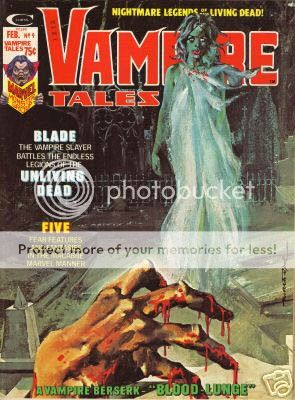
This article appeared in The Sandusky Register on December 28, 1919:
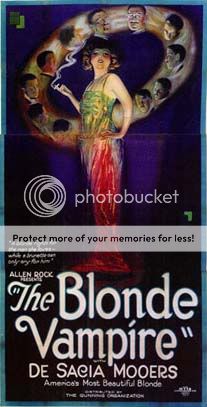
The pictures of Dracula below come from different sources. The first picture shows the original cover of Bram Stoker's book Dracula. This was the book from which the originally obscure legend of count Dracula gained its unprecendented fame.
The second is Dracula on the cover of the comics magazine Dracula. Here Dracula appears as a superhero, giving a weird twist to the original concept of evil.
The third picture is an old image of Vladislav Dracula, or Vlad Tepes the Impaler, the 15th century Romanian price who stood behind the myth. The name Dracula comes from the word "demon" in Romanian and etymologically related to the word "dracon" or "dragon."
The forth picture is a production staff printer's film negative sheet used in the production and printing of the VAMPIRELLA comics, starring the sexy woman vampire from Harris Comics/Warren Publications.
The fifth picture is a woodblock print of the attoricities of Vlad the Impaler, more commonly known by the name of Dracula.
The sixth picture is the cover of the comics magazine The Tomb of Dracula, showing Dracula escaping with a woman in his arms.
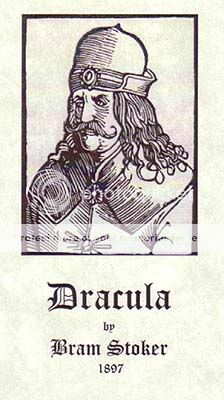
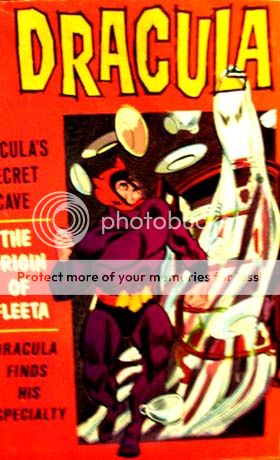


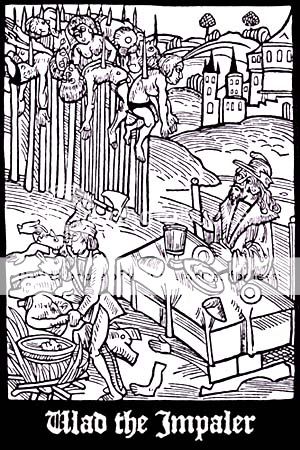
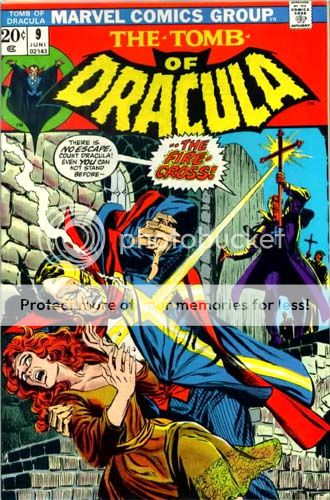
This story appeared in The Zanesville Signal on November 20, 1927 under the title "New Facts about Vampires: Winged and Human."
The word "vampire," aside from its current slang significance, suggests superstition, ghosts, werewolves, hobgoblins, purely fabulous monsters, fiction tales of so-called "mystery and horror" based on highly wrought literary imagination rather than any shred of fact.
In these weird tales the vampire is sometimes a huge bat, sometimes a beautiful woman, sometimes, as in the case of Count Dracula, a man with a mania for sucking human life-blood. Dracula is the classic type of fictional human vampire. He was created by Bram Stoker, a British writer of horror stories, and instantly became the literary rage all over the world. The Count's popularity has lasted twenty years; he is now the hero of a play based on Stoker's book, adapted by the American journalist, John Balderstori, and enjoying runs in York City and London. Women frequently faint at the matinee performances.
It seems now proved beyond any possibility of scientific doubt that such sinister and dangerous creatures, both bat and human, actually exist. Only a few weeks ago from mysterious Haiti, but from the quite modernized town Of Aux Cayes in that tropical West Indian island, where American Marine officers in motor cars pass every day, came the authenticated confession of a coppery-haired, handsome mulatto woman, by name Anastasie Dieudonne, that she had for several months been draining the blood from her nine-year old niece.
The child, once healthy and robust, had begun to fade away. Neighbors and relatives thought she had some wasting disease. Physicians, including those of the American clinic at Trouin, could find nothing wrong with her. Then an old black native doctor was called into conference. "She is the victim," he said, "of a vampire, or a loup garon. The life-blood is being secretly sucked from her body. If the monster is not discovered, she will die." "Bosh!" said many of the natives, who are not very superstitious in a modernized town like Aux Cayes. It looked like, bosh, indeed, when the old man carefully went over the girl's entire body and found not even a pinch-prick. But he was not satisfied and made a second examination. This time he discovered, a small, clean, unhealed incision hidden on the middle of her great toe. Anastasie Dieudonne subsequently confessed that she had been giving the girl a stupefying vegetable drug and then sucking her blood. She was, of course, an unbalanced creature, driven to this dreadful practice by an uncontrollable urge. She was literally, in actual fact, a human vampire.
That there are and have been other human vampires, in both high and low walks of life, and in circumstances much more terrible and dramatic than the case in Haiti, will presently be shown.
With reference to bat vampires, Dr. August Kronheit of the German Academy of Science, and member of a number of leading American societies, has made an elaborate study of them in South America.
He discovered that the true vampire is a montrous blackish-brown bat, with a wing-spread of about two feet, with razor-sharp teeth and a hideous snout like a pig. It flies chiefly in the late hours of the night, attacking sleeping horses, other animals and human beings. It lives almost entirely by sucking blood.
Dr Kronheit cites the specific case of a young girl in Bolivia, who was sleeping during the Summer on the unscreened porch of her father's house. By merest accident the father, who was planning a hunting trip next day, went out on the porch, just as dawn was lighting the sky, to observe the weather.
He saw the huge bat crouching against his daughter's bare shoulder, and with horror recognized it for what it was. He seized it and crushed it to death with his hands. It was then discovered that the vampire had sucked almost a pint of blood from the girl.
These true accounts of the vampire need frighten no reader in the continent of North America. The true vampire bat is confined exclusively to tropical countries, and never comes even so far north as Florida. The bats of the United States are harmless and, in many cases, useful. The useful ones live on insects; others by sucking the juice from fruit on trees. In the United States there is a large bat with a wingspread of more than fourteen inches, which is sometimes called "vampire," but which is known to science under the name of "false vampire," because it sucks only the juices of fruits.
But the existence of the real blood-sucking bats in tropical countries has been conclusively proved by science. One reason why people m general have hesitated to believe in them and regarded them as fictitious is that it has been difficult to understand, in common sense, why victims do not awaken when the vampire fastens upon them. Those who did believe in them invented the fantastic explanation that some insidious, sleep-producing poison was first injected from the bat's fangs into the victim's body. The true explanation is simpler. The upper front teeth of the vampire are flat, thin, unpointed and razorsharp. The vampire, properly speaking, neither bites nor sinks fangs like a needle into its victim. Instead, it delicately shaves off a thin portion of the skin, not deep, and the wound is practically painless. Then it applies its lips only to the spot, which is little more than an abrasion, and by suction alone keeps up a constant flow of blood.
Human vampires, on the other hand, are demented or semi-insane people who have a mania for drinking human blood. Recent investigations both current and historical, have shown that it is not so rare an occurrence as one might suppose.
The most completely authenticated case in history, since it is a part of actual old court record, is that of the beautiful Countess Bathori, who lived in Hungary about three hundred years ago. The complete minutes of the trial, her final confession, the testimony of her servants, the record of the conviction and the amazing punishment inflicted on her by the law-all still exist.
She was rich and owned a castle on the edge of the Carpathian Mountains, which had a mysterious and evil reputation in the neighborhood. For many years the peasants believed that she practiced magic, and was, in league, like Faust, with the devil. They did not dream, however, of the even more dreadful secret that the castle actually hid, for what occurred there, over and over again, was more terrifying than anything in the Bluebeard stories or the horror tales of Poe.
Over a period of several years a number of young and pretty peasant girls and boys had disappeared from the neighborhood and had never been heard from again. For a long time it was supposed that they had been carried off by bandits from the mountains. But finally suspicion was directed toward the already mysterious castle of the Countess Bathori, and after an investigation a company of the King's Guard appeared suddenly one night with search warrants from the Emperor, placed the Countess under arrest and thoroughly searched the castle.
In an underground dungeon they found six of the missing children, emaciated, but still alive, chained so that they could not kill themselves, which they would all too willingly have done to escape the slower death they were suffering. The bones of several others who had finally died were found in an oubliette. The Countess herself, under subsequent threats of legal torture, confessed that each night she went to the dungeon, opened a vein in the arm of one of the prisoners, drank quantities of blood, and also bathed her face and shoulders in it. She believed, in her mad, magical superstition, that this would keep her always young and beautiful. As a matter of fact, the records say, she had a marvelously smooth and lovely skin, a complexion like "snow and roses." It was a cruel period, and Hungary in those days was a cruel country. Instead of executing the Countess Bathori, the judges sentenced her, making the punishment fit the crime, to have the skin flayed from her face and neck. So her face became an object frightful to look upon instead of beautiful, as it had once been.
The most famous case of a modern human vampire attested by the courts and legal record is that of Fritz Haarman, in Hanover, Germany, who was executed after the World War. He was a true vampire, scientifically speaking. He lured no less than twenty-seven youths into his home and drank their blood.
The existence of such living human monsters as Anastasie Dieudonne in Haiti, Fritz Haarman in Germany and the Countess Bathori in Hungary is believed to be the basis for the legends concerning a third type of vampire which exists only in superstition and folklore. That is the vampire ghost, the dead man or woman, who periodically emerges from the grave to feed upon the blood of a living person. A whole literature has been built up around these folklore legends, and there are thousands of hair-raising stories. The best of them all, perhaps, is the "Succubus" by Balzac, which was illustrated by Gustave Dore. The most famous of them is probably "Dracula," with Robert Louis Stevenson's "Ollalla," a blood-curdling story, as runner-up.
These stories, common to the peasantry of all European countries, tell how, when the vampire's grave is opened, the body, no matter how long dead, is found to be still fresh and rosy. To put a stop to the ravages of the supposed vampire, the people go solemnly to the cemetery, open the grave and drive a stake through the heart. Then the grave is closed again and boiling oil and vinegar are poured upon it.
http://www.logoi.com/notes/vampires.html
COMMENTS
-